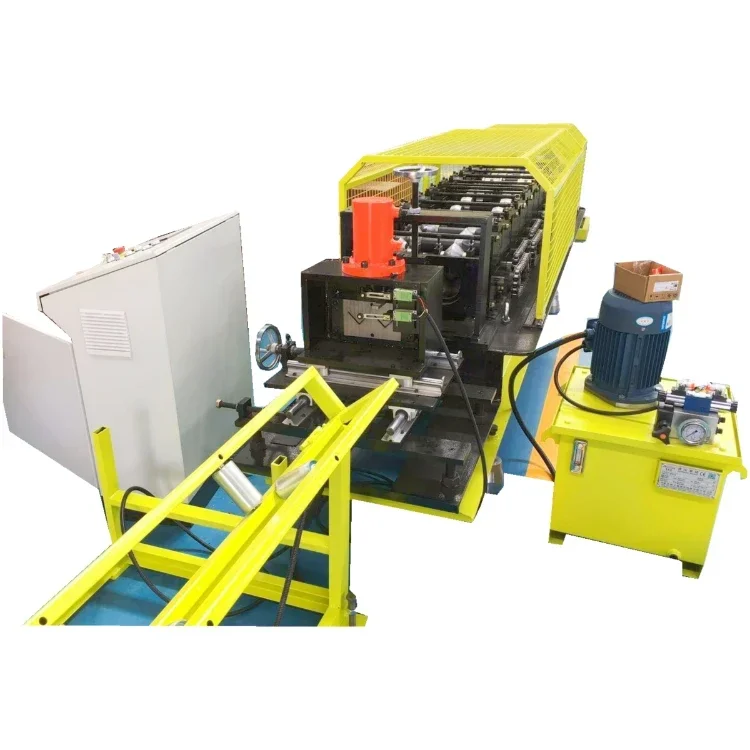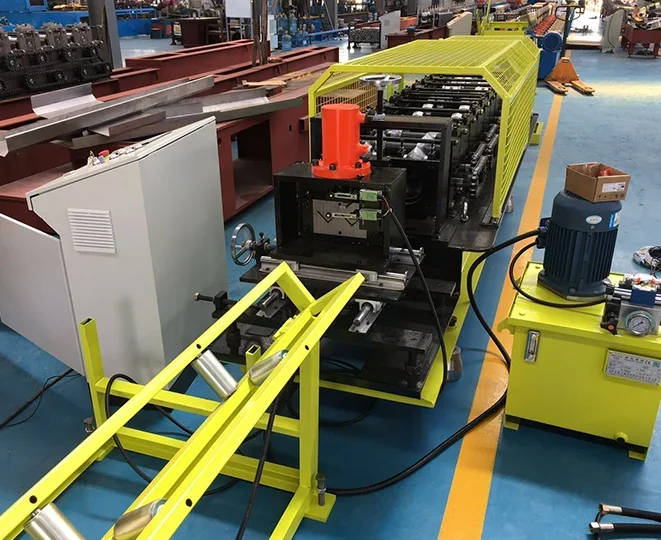In the realm of construction equipment, the stud track forming machine stands out as a pivotal tool. This innovative device revolutionizes the process of creating stud tracks efficiently and accurately. With its advanced technology and user-friendly design, this machine streamlines production while maintaining precision. From enhancing workflow to ensuring consistent quality, the stud track forming machine proves to be indispensable in modern construction projects. Stay tuned to explore the features, benefits, and applications of this cutting-edge equipment.
Metal Stud & Track Forming Basics
Purpose
Metal track members and studs are essential components in construction, providing structural support for walls, ceilings, and partitions. They offer durability and strength.
Metal studs are commonly used to frame interior walls due to their resistance to fire, mold, and termites. On the other hand, metal tracks serve as the horizontal support for the studs, ensuring stability.
Standard Sizes and Shapes
Galvanized steel is the primary material used to form metal studs and tracks. These components come in various sizes, typically ranging from 2.5 inches to 8 inches in width and 6 feet to 12 feet in length.
The shapes of metal studs can vary based on the specific requirements of a project. Common shapes include C-shaped studs for framing walls and U-shaped tracks for providing top and bottom support.
Benefits
Using metal studs and tracks offers several advantages over traditional materials like wood. One key benefit is their resistance to moisture, rotting, warping, and pests such as termites.
Moreover, metal studs are lightweight yet strong, making them easier to handle during installation while ensuring structural integrity. They also contribute to sustainable building practices by being recyclable.
-
Pros:
-
Durable and long-lasting
-
Resistant to fire and pests
-
Lightweight for easy handling
-
Metal studs and tracks provide a reliable framework for various construction projects, offering stability, durability, and sustainability while outperforming traditional materials in many aspects.
Understanding Roll Forming Processes
Metal Sheet Shaping
Roll forming is a cold roll process that shapes metal sheets into desired profiles using a series of rollers. The metal sheet passes through consecutive rolls, gradually forming the specified shape.
The rollers in a roll forming machine work together to bend the metal sheet incrementally, ensuring precise shaping along the entire length. This process allows for the creation of complex and continuous profiles with high accuracy.
Importance of Precision
Precision is crucial in roll forming to achieve consistent results across multiple pieces. Even minor variations in the shaping process can lead to defects or inconsistencies in the final product.
Maintaining tight tolerances during roll forming ensures that each piece meets the required specifications, leading to uniformity in dimensions and quality. This precision is essential, especially in industries where standardized components are necessary.
Types of Profiles
Roll forming techniques can produce a wide range of profiles, including C-channels, Z-sections, hat channels, and more. Each profile serves specific purposes based on its design and structural properties.
C-channels are commonly used for framing applications due to their strength and versatility. Z-sections offer enhanced load-bearing capabilities, making them ideal for structural support elements. Hat channels provide excellent rigidity and are often utilized in roofing systems.

Key Features of High-Efficiency Machines
Heat Treatment
Stud track forming machines with heat treatment capabilities ensure the durability and strength of the formed studs. This process involves heating and cooling metals to alter their physical and mechanical properties, enhancing the overall quality of the final product.
Automated systems in stud track forming machines play a crucial role in boosting efficiency. By automating various processes such as material feeding, cutting, and shaping, these machines can operate at high speeds while maintaining precision in forming studs. The integration of automation minimizes manual intervention, reducing errors and increasing productivity significantly.
Speed
The speed at which a stud track forming machine operates directly impacts its efficiency. Modern machines are designed to work at optimal speeds without compromising on quality. High-speed roll forming equipment can produce a large volume of studs within a short period, meeting the demands of fast-paced manufacturing environments efficiently.
Quick changeover capabilities are essential for modern roll forming equipment to adapt to varying production requirements swiftly. Machines that offer rapid changeover features enable manufacturers to switch between different stud profiles or sizes seamlessly. This flexibility reduces downtime between production runs, maximizing overall operational efficiency.
Material Considerations for Construction
Types of Materials
Metal stud and track forming machines utilize a variety of materials in their construction. Steel is commonly used due to its durability, strength, and resistance to corrosion. Aluminum is another popular choice for its lightweight properties and resistance to rust.
Factors for Selection
When choosing materials for specific construction projects, factors such as thickness, quality, and longevity play a crucial role. The thickness of the material determines its strength and ability to withstand loads, while the quality ensures reliability in performance over time.
Importance of Durability
The durability of materials used in stud and track forming machines directly impacts the overall quality and lifespan of the final products. Durability ensures that the components can withstand harsh conditions on construction sites without compromising structural integrity.
Sustainability Considerations
In the construction industry, sustainability is becoming increasingly important. Selecting materials with a focus on sustainability not only benefits the environment but also contributes to long-term cost savings. Using recyclable materials minimizes waste and reduces the carbon footprint of construction projects.

Benefits of Using a Stud Track Forming Machine
Increased Efficiency
Stud track forming machines significantly boost efficiency in construction projects by automating the process of creating metal studs and tracks. This automation speeds up production, allowing for quicker completion of framing tasks.
The machine's ability to precisely form studs and tracks according to set measurements ensures consistency in the construction process. This results in uniform structures, reducing errors and minimizing rework.
Cost Savings
Using a stud track forming machine can lead to substantial cost savings for construction companies. By producing metal studs and tracks in-house, businesses can eliminate the need to purchase prefabricated components, reducing overall expenses.
Moreover, the precision and accuracy of these machines contribute to minimizing material wastage, further driving down costs. This is particularly beneficial for projects with tight budgets or those aiming to optimize resource utilization.
Versatility and Customization
Stud track forming machines offer a high degree of versatility, allowing construction professionals to create customized studs and tracks tailored to specific project requirements. This flexibility enables builders to meet unique design specifications with ease.
These machines can accommodate various types of materials, including steel and aluminum, providing options for different construction needs. Whether it's for residential, commercial, or industrial projects, the adaptability of stud track forming machines makes them valuable assets on job sites.
Applications of Metal Studs and Tracks
Framing Walls
Metal studs and tracks play a crucial role in framing walls within the construction industry. They are ideal for creating sturdy frameworks that support various types of walls, from interior partitions to exterior walls. These components provide structural integrity, ensuring the durability and longevity of the walls.
Metal studs and tracks offer precise dimensions, making them easy to install and work with during wall framing projects. Their lightweight nature simplifies handling and transportation on job sites, enhancing overall efficiency in construction processes. These materials are resistant to warping, shrinking, or rotting, ensuring the stability of the walls over time.
Ceiling Installation
When it comes to ceiling installations, metal studs and tracks are preferred choices due to their strength and durability. These components can effectively support the weight of ceiling materials such as drywall or panels without compromising structural integrity. Contractors rely on metal studs and tracks to create robust frameworks that withstand the test of time.
Metal studs and tracks enable versatile designs for ceilings, allowing for customized solutions based on project requirements. Whether it's a suspended ceiling system or a traditional ceiling installation, these components provide flexibility in design while maintaining high levels of strength and stability. Their corrosion-resistant properties make them suitable for various indoor environments.
Partition Systems
In construction projects requiring partition systems, metal studs and tracks offer efficient solutions for creating distinct spaces within a structure. These components allow contractors to divide areas into separate rooms or sections without compromising structural soundness. The use of metal studs and tracks ensures that partitions are stable and secure.
Metal studs and tracks facilitate quick installation processes for partition systems, enabling contractors to complete projects within specified timelines. Their compatibility with a wide range of finishes makes them versatile options for creating visually appealing partitions that meet both functional and aesthetic requirements. Contractors appreciate the ease of working with these materials for partition projects.
Efficient Features of Roll Forming Machines
Energy Efficiency
Roll forming machines have evolved to prioritize energy efficiency in their operations. By optimizing power consumption, these machines reduce electricity costs and minimize environmental impact. The use of advanced technologies such as variable frequency drives contributes to significant energy savings.
Integrated Software Systems
The integration of software systems plays a crucial role in enhancing the performance of roll forming machines. These systems enable precise control over various parameters, resulting in higher production accuracy and efficiency. Operators can easily monitor and adjust settings through user-friendly interfaces.
Safety Features
Safety is paramount in roll forming machines, with safety features being integrated to protect operators from potential hazards. Emergency stop buttons, safety guards, and sensors are standard components that ensure the well-being of individuals working with these machines. Regular maintenance and operator training further enhance safety protocols.

Summary
The exploration of metal stud and track forming machines revealed the intricate process behind their production, emphasizing the efficiency and material considerations crucial for construction projects. Understanding roll forming processes shed light on the key features of high-efficiency machines, showcasing their benefits and diverse applications in the industry. The efficient features of roll forming machines highlighted the importance of precision and reliability in manufacturing metal studs and tracks, underlining their pivotal role in modern construction practices.
Frequently Asked Questions
How does a stud track forming machine work?
A stud track forming machine works by feeding metal coils through a series of rollers that gradually shape the metal into studs and tracks used in construction. The machine cuts, punches, and forms the metal to create precise shapes for building frames.
What are the benefits of using a stud track forming machine?
Using a stud track forming machine increases efficiency in producing metal studs and tracks for construction projects. It ensures consistent quality, reduces material waste, speeds up production, and allows customization of shapes according to project requirements.
What materials are commonly used with stud track forming machines?
Stud track forming machines typically work with galvanized steel, stainless steel, or aluminum coils. These materials are chosen for their strength, durability, and corrosion resistance, making them ideal for constructing frameworks in various buildings and structures.
What are the key features to look for in high-efficiency stud track forming machines?
High-efficiency stud track forming machines should have features like quick changeover capabilities for different profiles, computerized controls for precision, automatic shearing mechanisms, and adjustable speed settings. These features contribute to increased productivity and accuracy in metal framing production.
In what applications can metal studs and tracks formed by these machines be used?
Metal studs and tracks produced by stud track forming machines are commonly used in interior partition walls, ceiling systems, curtain walls, load-bearing structures, and other framing applications in residential, commercial, industrial buildings due to their strength, versatility, and ease of installation.

